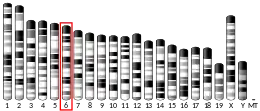CLCN1
The CLCN family of voltage-dependent chloride channel genes comprises nine members (CLCN1-7, Ka and Kb) which demonstrate quite diverse functional characteristics while sharing significant sequence homology. The protein encoded by this gene regulates the electric excitability of the skeletal muscle membrane. Mutations in this gene cause two forms of inherited human muscle disorders: recessive generalized myotonia congenita (Becker) and dominant myotonia (Thomsen).[5]
| CLCN1 | |||||||||||||||||||||||||||||||||||||||||||||||||||
|---|---|---|---|---|---|---|---|---|---|---|---|---|---|---|---|---|---|---|---|---|---|---|---|---|---|---|---|---|---|---|---|---|---|---|---|---|---|---|---|---|---|---|---|---|---|---|---|---|---|---|---|
| Identifiers | |||||||||||||||||||||||||||||||||||||||||||||||||||
| Aliases | CLCN1, CLC1, chloride voltage-gated channel 1 | ||||||||||||||||||||||||||||||||||||||||||||||||||
| External IDs | OMIM: 118425 MGI: 88417 HomoloGene: 63 GeneCards: CLCN1 | ||||||||||||||||||||||||||||||||||||||||||||||||||
| |||||||||||||||||||||||||||||||||||||||||||||||||||
| |||||||||||||||||||||||||||||||||||||||||||||||||||
| |||||||||||||||||||||||||||||||||||||||||||||||||||
| |||||||||||||||||||||||||||||||||||||||||||||||||||
| |||||||||||||||||||||||||||||||||||||||||||||||||||
| Wikidata | |||||||||||||||||||||||||||||||||||||||||||||||||||
| |||||||||||||||||||||||||||||||||||||||||||||||||||
Chloride channel protein, skeletal muscle (CLCN1) is a protein that in humans is encoded by the CLCN1 gene.[6] Mutations in this protein cause congenital myotonia.
CLCN1 is critical for the normal function of skeletal muscle cells. For the body to move normally, skeletal muscles must tense (contract) and relax in a coordinated way. Muscle contraction and relaxation are controlled by the flow of ions into and out of muscle cells. CLCN1 forms an ion channel that controls the flow of negatively charged chloride ions into these cells. The main function of this channel is to stabilize the cells' electrical charge, enabling muscles to contract normally.
In people with congenital myotonia due to a mutation in CLCN1, the ion channel admits too few chloride ions into the cell. This shortage of chloride ions causes prolonged muscle contractions, which are the hallmark of myotonia.
See also
References
- GRCh38: Ensembl release 89: ENSG00000188037 - Ensembl, May 2017
- GRCm38: Ensembl release 89: ENSMUSG00000029862 - Ensembl, May 2017
- "Human PubMed Reference:". National Center for Biotechnology Information, U.S. National Library of Medicine.
- "Mouse PubMed Reference:". National Center for Biotechnology Information, U.S. National Library of Medicine.
- "Entrez Gene: CLCN1 chloride channel 1, skeletal muscle (Thomsen disease, autosomal dominant)".
- Koch MC, Steinmeyer K, Lorenz C, Ricker K, Wolf F, Otto M, Zoll B, Lehmann-Horn F, Grzeschik KH, Jentsch TJ (Sep 1992). "The skeletal muscle chloride channel in dominant and recessive human myotonia". Science. 257 (5071): 797–800. Bibcode:1992Sci...257..797K. doi:10.1126/science.1379744. PMID 1379744.
Further reading
- Hudson AJ, Ebers GC, Bulman DE (1995). "The skeletal muscle sodium and chloride channel diseases". Brain. 118 (2): 547–63. doi:10.1093/brain/118.2.547. PMID 7735894.
- Uchida S, Sasaki S, Marumo F (1996). "Chloride transport across kidney epithelia through CLC chloride channels". Nippon Jinzo Gakkai Shi. 38 (7): 285–9. PMID 8741388.
- Fahlke C (2000). "Molecular mechanisms of ion conduction in ClC-type chloride channels: lessons from disease-causing mutations". Kidney Int. 57 (3): 780–6. doi:10.1046/j.1523-1755.2000.00915.x. PMID 10720929.
- Pusch M (2002). "Myotonia caused by mutations in the muscle chloride channel gene CLCN1". Hum. Mutat. 19 (4): 423–34. doi:10.1002/humu.10063. PMID 11933197. S2CID 41727736.
- Colding-Jørgensen E (2005). "Phenotypic variability in myotonia congenita". Muscle Nerve. 32 (1): 19–34. doi:10.1002/mus.20295. PMID 15786415. S2CID 8336138.
- Isobe M, Erikson J, Emanuel BS, et al. (1985). "Location of gene for beta subunit of human T-cell receptor at band 7q35, a region prone to rearrangements in T cells". Science. 228 (4699): 580–2. Bibcode:1985Sci...228..580I. doi:10.1126/science.3983641. PMID 3983641.
- Lehmann-Horn F, Mailänder V, Heine R, George AL (1995). "Myotonia levior is a chloride channel disorder". Hum. Mol. Genet. 4 (8): 1397–402. doi:10.1093/hmg/4.8.1397. PMID 7581380.
- George AL, Sloan-Brown K, Fenichel GM, et al. (1995). "Nonsense and missense mutations of the muscle chloride channel gene in patients with myotonia congenita". Hum. Mol. Genet. 3 (11): 2071–2. PMID 7874130.
- Lorenz C, Meyer-Kleine C, Steinmeyer K, et al. (1994). "Genomic organization of the human muscle chloride channel CIC-1 and analysis of novel mutations leading to Becker-type myotonia". Hum. Mol. Genet. 3 (6): 941–6. doi:10.1093/hmg/3.6.941. PMID 7951242.
- Heine R, George AL, Pika U, et al. (1995). "Proof of a non-functional muscle chloride channel in recessive myotonia congenita (Becker) by detection of a 4 base pair deletion". Hum. Mol. Genet. 3 (7): 1123–8. doi:10.1093/hmg/3.7.1123. PMID 7981681.
- George AL, Crackower MA, Abdalla JA, et al. (1995). "Molecular basis of Thomsen's disease (autosomal dominant myotonia congenita)". Nat. Genet. 3 (4): 305–10. doi:10.1038/ng0493-305. PMID 7981750. S2CID 12286250.
- Steinmeyer K, Lorenz C, Pusch M, et al. (1994). "Multimeric structure of ClC-1 chloride channel revealed by mutations in dominant myotonia congenita (Thomsen)". EMBO J. 13 (4): 737–43. doi:10.1002/j.1460-2075.1994.tb06315.x. PMC 394869. PMID 8112288.
- Koch MC, Ricker K, Otto M, et al. (1994). "Evidence for genetic homogeneity in autosomal recessive generalised myotonia (Becker)". J. Med. Genet. 30 (11): 914–7. doi:10.1136/jmg.30.11.914. PMC 1016598. PMID 8301644.
- Meyer-Kleine C, Steinmeyer K, Ricker K, et al. (1996). "Spectrum of mutations in the major human skeletal muscle chloride channel gene (CLCN1) leading to myotonia". Am. J. Hum. Genet. 57 (6): 1325–34. PMC 1801423. PMID 8533761.
- Mailänder V, Heine R, Deymeer F, Lehmann-Horn F (1996). "Novel muscle chloride channel mutations and their effects on heterozygous carriers". Am. J. Hum. Genet. 58 (2): 317–24. PMC 1914535. PMID 8571958.
- Pusch M, Steinmeyer K, Koch MC, Jentsch TJ (1996). "Mutations in dominant human myotonia congenita drastically alter the voltage dependence of the CIC-1 chloride channel". Neuron. 15 (6): 1455–63. doi:10.1016/0896-6273(95)90023-3. PMID 8845168. S2CID 18808219.
- Fahlke C, Beck CL, George AL (1997). "A mutation in autosomal dominant myotonia congenita affects pore properties of the muscle chloride channel". Proc. Natl. Acad. Sci. U.S.A. 94 (6): 2729–34. Bibcode:1997PNAS...94.2729F. doi:10.1073/pnas.94.6.2729. PMC 20158. PMID 9122265.
External links
- GeneReviews/NCBI/NIH/UW entry on Myotonia Congenita
- CLCN1+protein,+human at the U.S. National Library of Medicine Medical Subject Headings (MeSH)
- Human CLCN1 genome location and CLCN1 gene details page in the UCSC Genome Browser.
This article incorporates text from the United States National Library of Medicine, which is in the public domain.




